2017 TOYOTA YARIS fuel type
[x] Cancel search: fuel typePage 13 of 396

13Pictorial index
Wipers . . . . . . . . . . . . . . . . . . . . . . . . . . . . . . . . . . . . . . . P. 150, 153
Precautions against winter season . . . . . . . . . . . . . . . . . . . . . P. 197
Fuel filler door . . . . . . . . . . . . . . . . . . . . . . . . . . . . . . . . . . . . P. 156
Refueling method . . . . . . . . . . . . . . . . . . . . . . . . . . . . . . . . . . . P. 156
Fuel type/fuel tank capacity . . . . . . . . . . . . . . . . . . . . . . . . . . . P. 340
Tires . . . . . . . . . . . . . . . . . . . . . . . . . . . . . . . . . . . . . . . . . . . . P. 253
Tire size/inflation pressure . . . . . . . . . . . . . . . . . . . . . . . . . . . . P. 345
Winter tires/tire chain . . . . . . . . . . . . . . . . . . . . . . . . . . . . . . . . P. 198
Checking/rotation . . . . . . . . . . . . . . . . . . . . . . . . . . . . . . . . . . . P. 253
Coping with flat tires . . . . . . . . . . . . . . . . . . . . . . . . . . . . . . . . P. 312
Hood . . . . . . . . . . . . . . . . . . . . . . . . . . . . . . . . . . . . . . . . . . . . P. 239
Opening . . . . . . . . . . . . . . . . . . . . . . . . . . . . . . . . . . . . . . . . . . P. 239
Engine oil . . . . . . . . . . . . . . . . . . . . . . . . . . . . . . . . . . . . . . . . . P. 340
Coping with overheat . . . . . . . . . . . . . . . . . . . . . . . . . . . . . . . . P. 330
Headlights/daytime running lights . . . . . . . . . . . . . . . . . . . . P. 145
Fog lights
* . . . . . . . . . . . . . . . . . . . . . . . . . . . . . . . . . . . . . . . P. 148
Turn signal lights . . . . . . . . . . . . . . . . . . . . . . . . . . . . . . . . . . P. 143
Stop/tail lights . . . . . . . . . . . . . . . . . . . . . . . . . . . . . . . . . . . . P. 145
License plate lights . . . . . . . . . . . . . . . . . . . . . . . . . . . . . . . . P. 145
Back-up lights
Shifting the shift lever to R . . . . . . . . . . . . . . . . . . . . . . . . P. 139, 142
4
5
6
7
Light bulbs of the exterior lights for driving
(Replacing method: P. 278, Watts: P. 346)
*: If equipped
8
9
10
11
12
13
Page 147 of 396
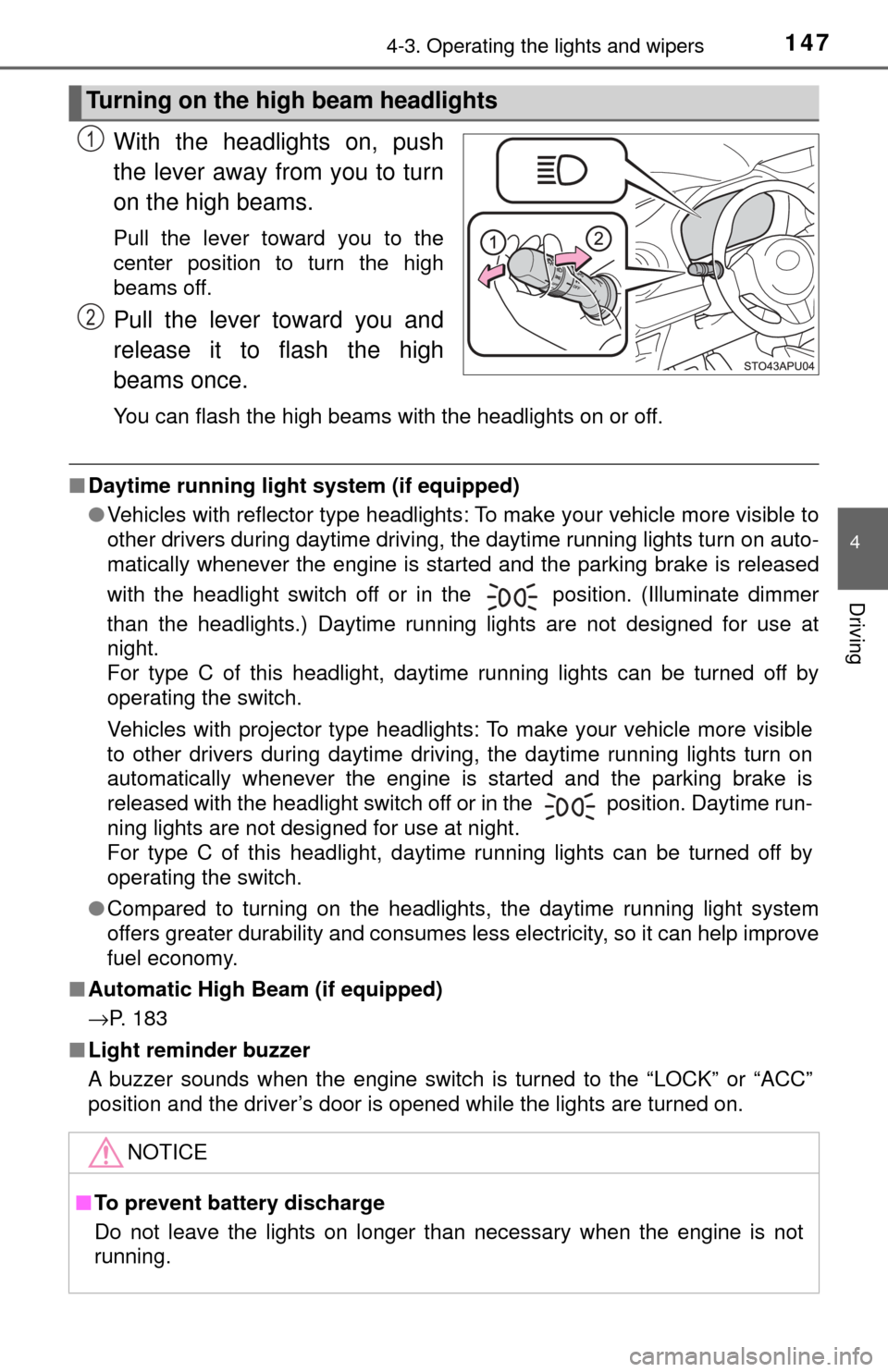
1474-3. Operating the lights and wipers
4
Driving
With the headlights on, push
the lever away from you to turn
on the high beams.
Pull the lever toward you to the
center position to turn the high
beams off.
Pull the lever toward you and
release it to flash the high
beams once.
You can flash the high beams with the headlights on or off.
■Daytime running light system (if equipped)
●Vehicles with reflector type headlights: To make your vehicle more visible to
other drivers during daytime driving, the daytime running lights turn on auto-
matically whenever the engine is started and the parking brake is released
with the headlight switch off or in the position. (Illuminate dimmer
than the headlights.) Daytime running lights are not designed for use at
night.
For type C of this headlight, daytime running lights can be turned off by
operating the switch.
Vehicles with projector type headlights: To make your vehicle more visible
to other drivers during daytime driving, the daytime running lights turn on
automatically whenever the engine is started and the parking brake is
released with the headlight switch off or in the position. Daytime run-
ning lights are not designed for use at night.
For type C of this headlight, daytime running lights can be turned off by
operating the switch.
● Compared to turning on the headlights, the daytime running light system
offers greater durability and consumes less electricity, so it can help improve
fuel economy.
■ Automatic High Beam (if equipped)
→P. 183
■ Light reminder buzzer
A buzzer sounds when the engine switch is turned to the “LOCK” or “ACC”
position and the driver’s door is opened while the lights are turned on.
Turning on the high beam headlights
1
2
NOTICE
■To prevent battery discharge
Do not leave the lights on longer than necessary when the engine is not
running.
Page 156 of 396
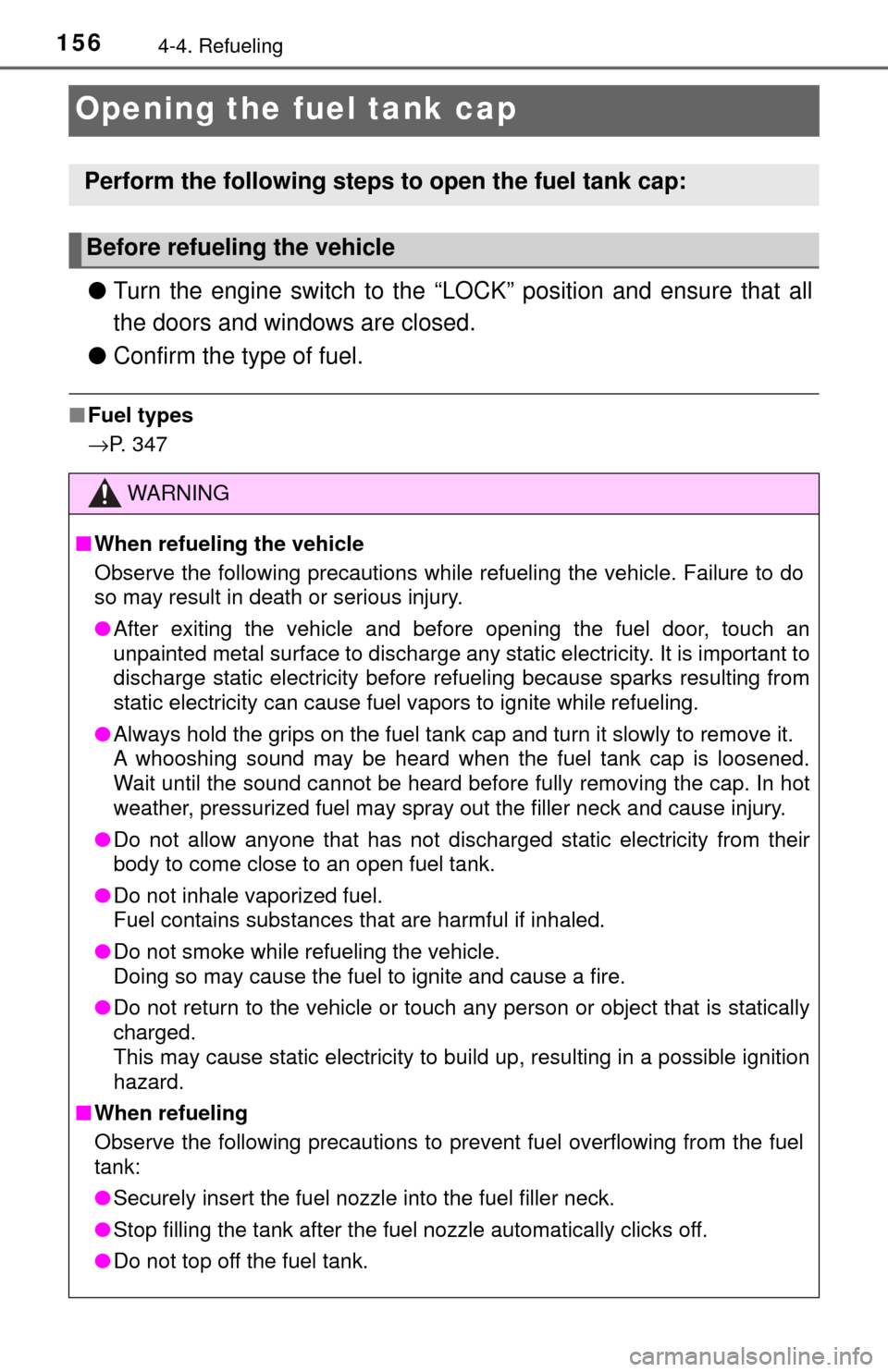
1564-4. Refueling
Opening the fuel tank cap
●Turn the engine switch to the “LOC K” position and ensure that all
the doors and windows are closed.
● Confirm the type of fuel.
■Fuel types
→P. 347
Perform the following steps to open the fuel tank cap:
Before refueling the vehicle
WARNING
■When refueling the vehicle
Observe the following precautions while refueling the vehicle. Failure to do
so may result in death or serious injury.
● After exiting the vehicle and before opening the fuel door, touch an
unpainted metal surface to discharge any static electricity. It is important to
discharge static electricity before refueling because sparks resulting from
static electricity can cause fuel vapors to ignite while refueling.
● Always hold the grips on the fuel tank cap and turn it slowly to remove it.
A whooshing sound may be heard when the fuel tank cap is loosened.
Wait until the sound cannot be heard before fully removing the cap. In hot
weather, pressurized fuel may spray out the filler neck and cause injury.
● Do not allow anyone that has not discharged static electricity from their
body to come close to an open fuel tank.
● Do not inhale vaporized fuel.
Fuel contains substances that are harmful if inhaled.
● Do not smoke while refueling the vehicle.
Doing so may cause the fuel to ignite and cause a fire.
● Do not return to the vehicle or touch any person or object that is statically
charged.
This may cause static electricity to build up, resulting in a possible ignition
hazard.
■ When refueling
Observe the following precautions to prevent fuel overflowing from the fuel
tank:
● Securely insert the fuel nozzle into the fuel filler neck.
● Stop filling the tank after the fuel nozzle automatically clicks off.
● Do not top off the fuel tank.
Page 340 of 396
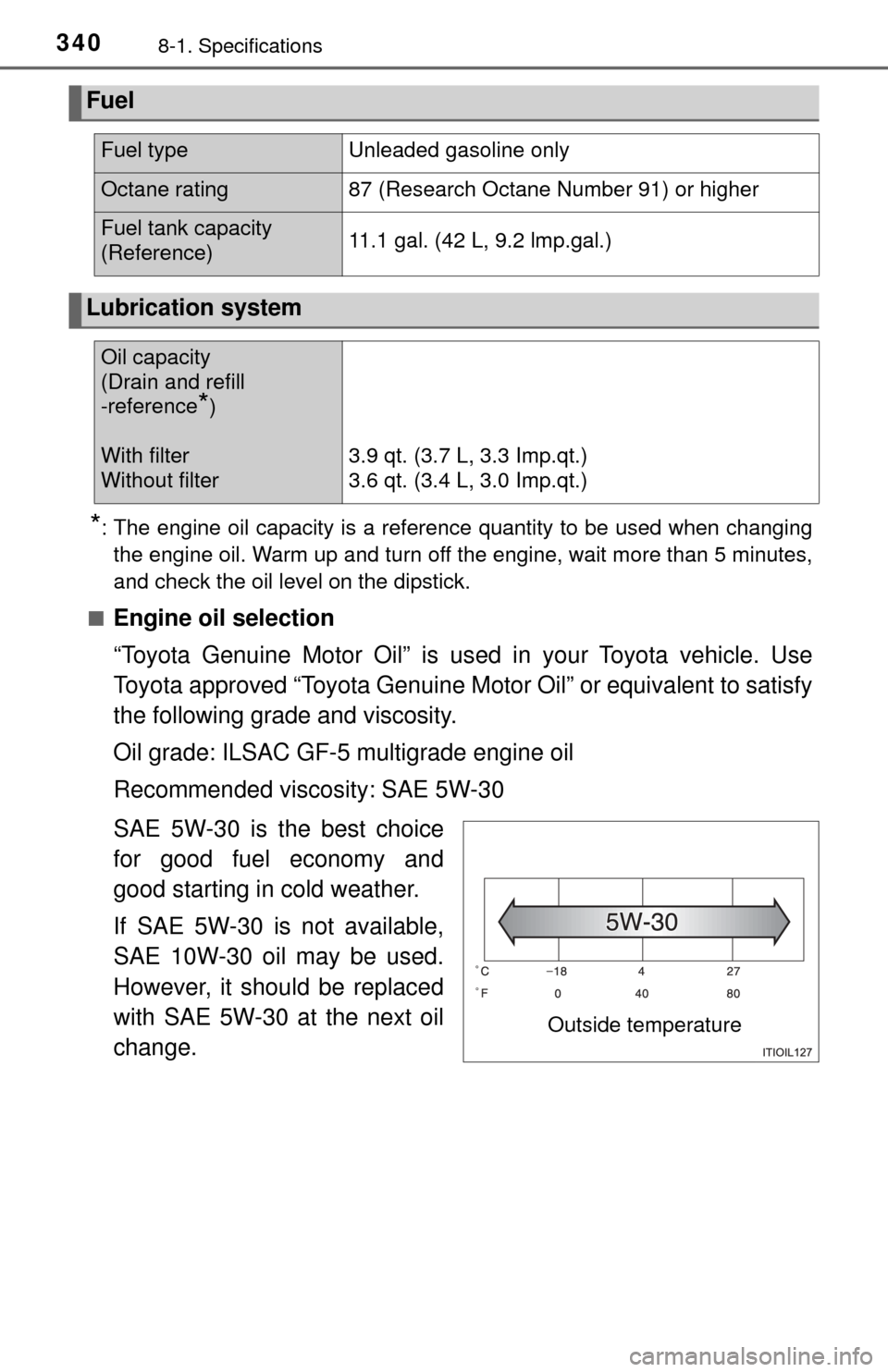
3408-1. Specifications
*: The engine oil capacity is a reference quantity to be used when changingthe engine oil. Warm up and turn off the engine, wait more than 5 minutes,
and check the oil level on the dipstick.
■
Engine oil selection
“Toyota Genuine Motor Oil” is us ed in your Toyota vehicle. Use
Toyota approved “Toyota Genuine Motor Oil” or equivalent to satisfy
the following grade and viscosity.
Oil grade: ILSAC GF-5 multigrade engine oil
Recommended viscosity: SAE 5W-30
SAE 5W-30 is the best choice
for good fuel economy and
good starting in cold weather.
If SAE 5W-30 is not available,
SAE 10W-30 oil may be used.
However, it should be replaced
with SAE 5W-30 at the next oil
change.
Fuel
Fuel typeUnleaded gasoline only
Octane rating87 (Research Octane Number 91) or higher
Fuel tank capacity
(Reference)11.1 gal. (42 L, 9.2 lmp.gal.)
Lubrication system
Oil capacity
(Drain and refill
-reference
*)
With filter
Without filter 3.9 qt. (3.7 L, 3.3 Imp.qt.)
3.6 qt. (3.4 L, 3.0 Imp.qt.)
Outside temperature
Page 343 of 396
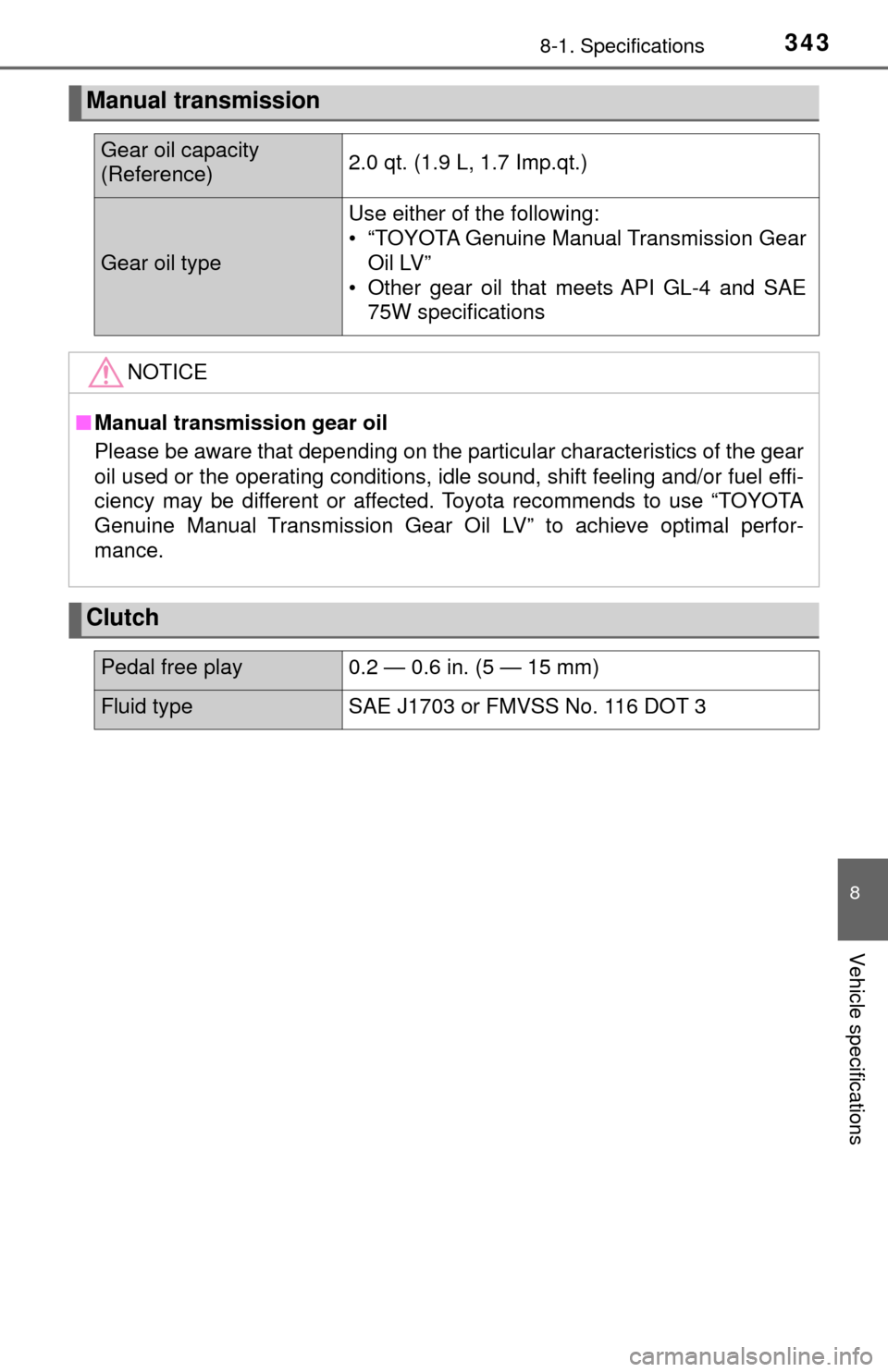
3438-1. Specifications
8
Vehicle specifications
Manual transmission
Gear oil capacity
(Reference)2.0 qt. (1.9 L, 1.7 Imp.qt.)
Gear oil type
Use either of the following:
• “TOYOTA Genuine Manual Transmission GearOil LV”
• Other gear oil that meets API GL-4 and SAE 75W specifications
NOTICE
■Manual transmission gear oil
Please be aware that depending on the particular characteristics of the gear
oil used or the operating conditions, idle sound, shift feeling and/or fuel effi-
ciency may be different or affected. Toyota recommends to use “TOYOTA
Genuine Manual Transmission Gear Oil LV” to achieve optimal perfor-
mance.
Clutch
Pedal free play0.2 — 0.6 in. (5 — 15 mm)
Fluid typeSAE J1703 or FMVSS No. 116 DOT 3
Page 349 of 396
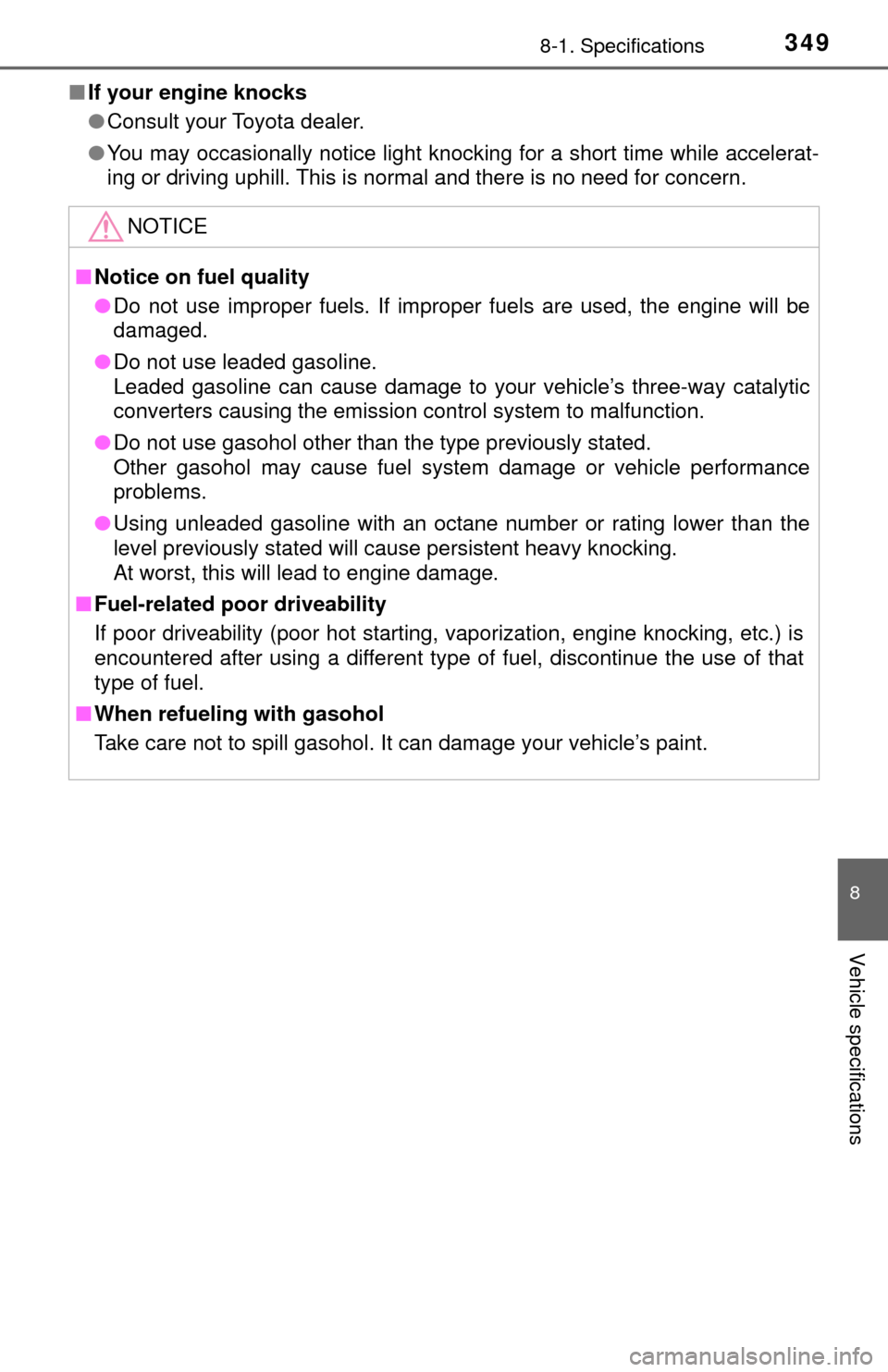
3498-1. Specifications
8
Vehicle specifications
■If your engine knocks
●Consult your Toyota dealer.
● You may occasionally notice light knocking for a short time while accelerat-
ing or driving uphill. This is normal and there is no need for concern.
NOTICE
■Notice on fuel quality
● Do not use improper fuels. If improper fuels are used, the engine will be
damaged.
● Do not use leaded gasoline.
Leaded gasoline can cause damage to your vehicle’s three-way catalytic
converters causing the emission control system to malfunction.
● Do not use gasohol other than the type previously stated.
Other gasohol may cause fuel system damage or vehicle performance
problems.
● Using unleaded gasoline with an octane number or rating lower than the
level previously stated will cause persistent heavy knocking.
At worst, this will lead to engine damage.
■ Fuel-related poor driveability
If poor driveability (poor hot starting, vaporization, engine knocking, etc.) is
encountered after using a different type of fuel, discontinue the use of that
type of fuel.
■ When refueling with gasohol
Take care not to spill gasohol. It can damage your vehicle’s paint.
Page 389 of 396

389Alphabetical index
FuelCapacity ................................ 340
Fuel gauge .............................. 77
Fuel pump shut off system.... 301
Information ............................ 347
Refueling............................... 156
Type .............................. 156, 340
Warning light ......................... 304
Fuel consumption Average fuel consumption ...... 81
Instantaneous fuel
consumption ......................... 81
Fuel filler door.......................... 156
Refueling............................... 156
Fuel pump shut off system ..... 301
Fuses ........................................ 273
Gas station information .......... 396
Gauges ....................................... 77
Glove box ................................. 215
Hazard lights Switch ................................... 292
Head restraints ........................ 104
Headlights ................................ 145 Automatic High Beam ........... 183
Light switch ........................... 145
Replacing light bulbs............. 279
Wattage ................................ 346
Heaters ..................................... 202 Manual air conditioning system ......... ....................... 202
Outside rear view mirrors...... 206
High mounted stoplight Replacing light bulbs............. 288
Hood ......................................... 239 Open ..................................... 239
Hooks
Retaining hooks (floor mat)..... 22
Horn .......................................... 107 Identification ............................ 337
Engine .................................. 338
Vehicle .................................. 337
Ignition switch
(engine switch) ...................... 136
Illuminated entry system ........ 213
Immobilizer system ................... 67
Indicators ................................... 74
Initialization Maintenance data ................. 231
Items to initialize ................... 365
Tire pressure warningsystem .......... ...................... 254
Inside rear view mirror ............ 109
Instrument panel light control ...................................... 78
Interior light ............................. 212 Switch ................................... 212
Wattage ................................ 346
Jack Positioning a floor jack.......... 241
Vehicle-equipped jack .......... 313
Jack handle .............................. 313
G
H
I
J
Page 392 of 396
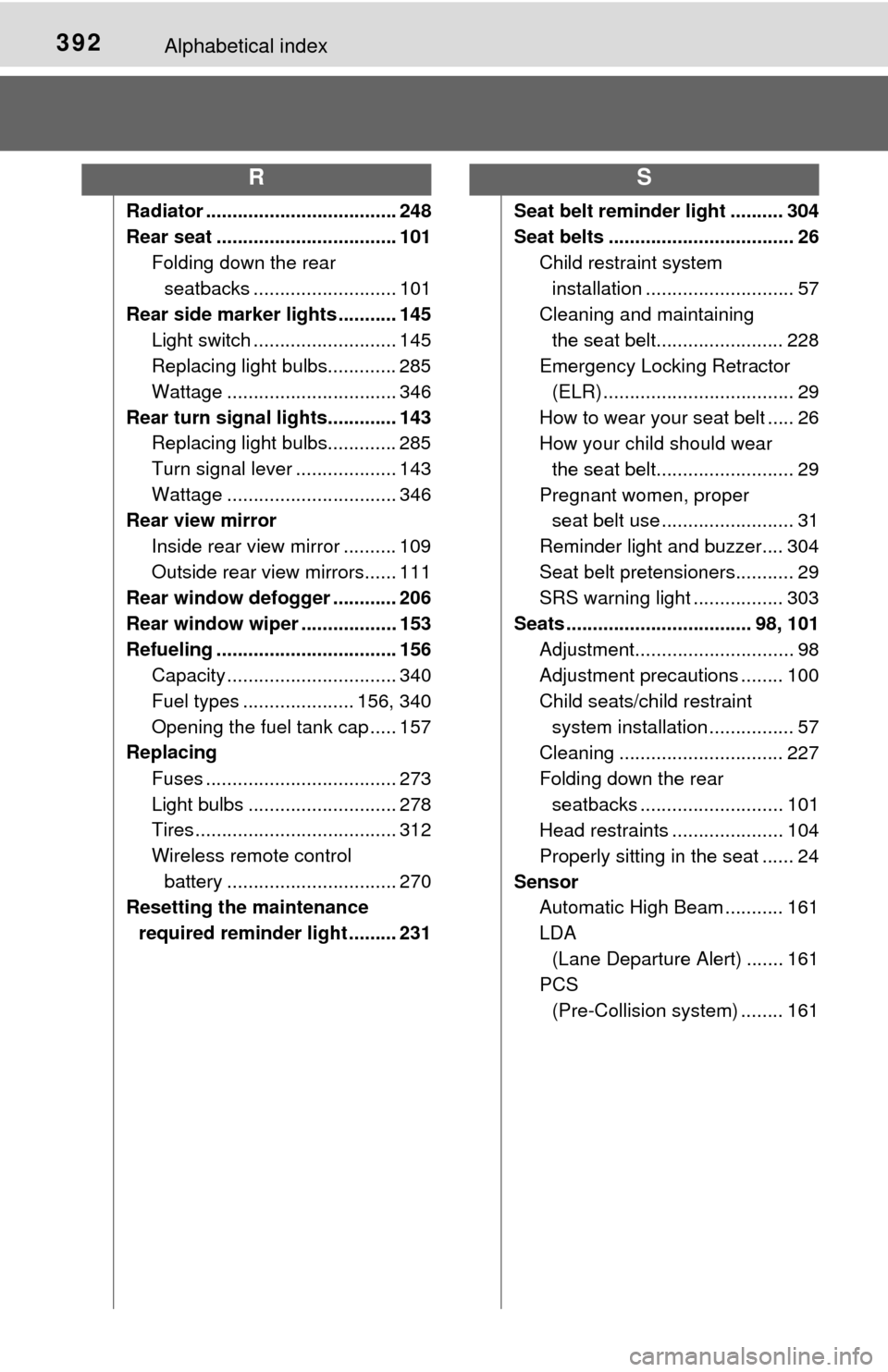
392Alphabetical index
Radiator .................................... 248
Rear seat .................................. 101Folding down the rear seatbacks ........................... 101
Rear side marker lights ........... 145 Light switch ........................... 145
Replacing light bulbs............. 285
Wattage ................................ 346
Rear turn signal lights............. 143 Replacing light bulbs............. 285
Turn signal lever ................... 143
Wattage ................................ 346
Rear view mirror
Inside rear view mirror .......... 109
Outside rear view mirrors...... 111
Rear window defogger ............ 206
Rear window wiper .................. 153
Refueling .................................. 156 Capacity ................................ 340
Fuel types ..................... 156, 340
Opening the fuel tank cap ..... 157
Replacing
Fuses .................................... 273
Light bulbs ............................ 278
Tires ...................................... 312
Wireless remote control battery ................................ 270
Resetting the maintenance
required reminder light ......... 231 Seat belt reminder light .......... 304
Seat belts ................................... 26
Child restra int system
installation ............................ 57
Cleaning and maintaining the seat belt........................ 228
Emergency Locking Retractor
(ELR) .................................... 29
How to wear your seat belt ..... 26
How your child should wear the seat belt.......................... 29
Pregnant women, proper seat belt use ......................... 31
Reminder light and buzzer.... 304
Seat belt pretensioners........... 29
SRS warning light ................. 303
Seats ................................... 98, 101 Adjustment.............................. 98
Adjustment precautions ........ 100
Child seats/child restraint system installation ................ 57
Cleaning ............................... 227
Folding down the rear
seatbacks ........................... 101
Head restraints ..................... 104
Properly sitting in the seat ...... 24
Sensor Automatic High Beam ........... 161
LDA
(Lane Departure Alert) ....... 161
PCS
(Pre-Collision system) ........ 161
RS